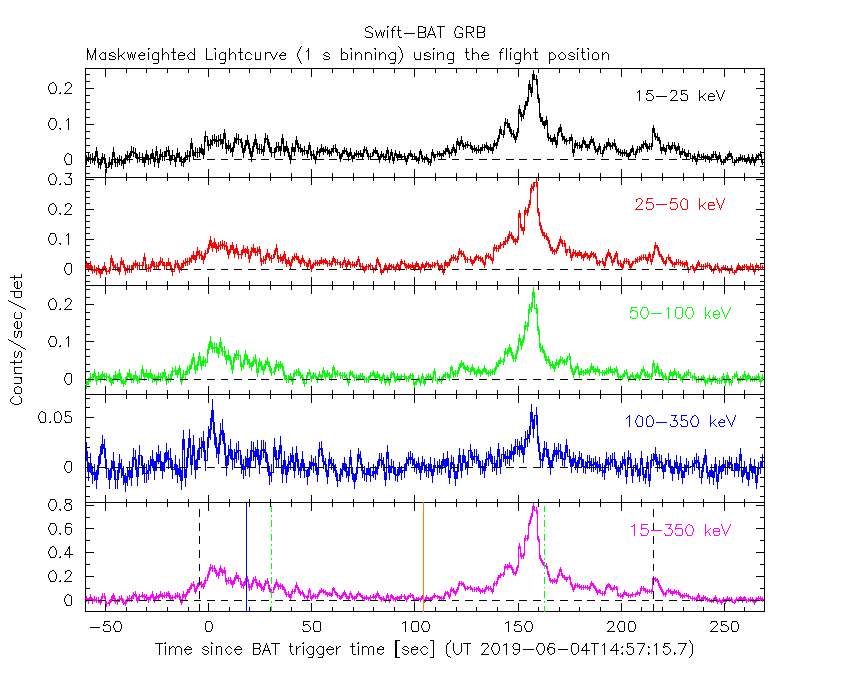
K.L. Page (U. Leicester), J.A. Kennea (PSU) and A.A. Breeveld (UCL-MSSL) for the Swift team
At 14:57:15 UT, the Swift Burst Alert Telescope (BAT) triggered and located GRB 190604B (trigger=906654) (Page et al. GCN Circ. 24742). Swift slewed immediately to the burst. At the time of the trigger, the initial BAT position was 139° from the Sun (9.0 hours West) and 152° from the 2%-illuminated Moon. Table 1 contains the best reported positions from Swift, and the latest XRT position can be viewed at http://www.swift.ac.uk/xrt_positions.
Breeveld and Page (GCN Circ. 24747) reported the detection with UVOT of an optical afterglow. Table 2 is a summary of GCN Circulars about this GRB from observatories other than Swift.
Standard analysis products for this burst are available at https://gcn.gsfc.nasa.gov/swift_gnd_ana.html.
As reported by Markwardt et al. (GCN Circ. 24752),
the BAT ground-calculated position is RA, Dec = 297.546, -32.975 deg which is RA(J2000) = 1
The mask-weighted light curve (Figure 1) shows a multi-peaked structure that starts from ~T-40 s and ends at ~T+240 s.
There are two major peaks that occur at ~
The time-averaged spectrum from T-39.776 s to T+239.504 s is best fit by a simple power-law model.
The power law index of the time-averaged spectrum is 1.81 ± 0.04.
The fluence in the 15-150 keV band is 1.77 ± 0.04 x 1
The results of the batgrbproduct analysis are available at https://gcn.gsfc.nasa.gov/notices_s/906654/BA/.
Analysis of the initial XRT data was reported by Kennea et al. (GCN Circ. 24749). We have analysed 14 ks of XRT data for GRB 190604B, from 120 s to 85.8 ks after the BAT trigger. The data comprise 285 s in Windowed Timing (WT) mode with the remainder in Photon Counting (PC) mode. The enhanced XRT position for this burst was given by Evans et al. (GCN Circ. 24743).
The late-time light curve (Figure 2) (from T0+4.9 ks) can be modelled with a power-law decay with a decay index of α=1.15 ± 0.06.
A spectrum formed from the WT mode data can be fitted with an absorbed power-law with a photon spectral index of 1.40 ± 0.03. The best-fitting absorption column is 1.49 (+0.16, -0.13) x 1
A summary of the PC-mode spectrum is thus:
Total column: 2.9 ± 0.4 x 1
Galactic foreground: 1.4 x 1
Excess significance: 6.1 σ
Photon index: 2.02 ± 0.11
The results of the XRT team automatic analysis are available at http://www.swift.ac.uk/xrt_products/00906654.
The Swift/UVOT began settled observations of the field of GRB 190604B 128 s after the BAT trigger
(Breeveld and Page GCN Circ. 24747).
A faint source is detected in the initial white UVOT exposure at a position consistent with the enhanced XRT source position (Evans et al., GCN Circ. 24746).
Table 3 gives preliminary
magnitudes using the UVOT photometric system
(Breeveld et al. 2011, AIP Conf. Proc., 1358, 373).
No correction has been made for the expected extinction in the Milky Way
corresponding to a reddening of

Figure 1. The BAT
mask-weighted light curve in the four individual and total
energy bands. The units are counts

Figure 2. The XRT light curve.
Any data from a crosshatched region are not included in the fit.
| RA (J2000) | Dec (J2000) | Error | Note | Reference |
|---|---|---|---|---|
| 1 |
-32°58'38.9" | 0.61" | UVOT | ? |
| 1 |
-32°58'40.6" | 1.4" | XRT-final | UKSSDC |
| 1 |
-32°58'40.9" | 1.9" | XRT-enhanced | Evans et al. GCN Circ. 24746 |
| 1 |
-32°58'31.1" | 1.0' | BAT-refined | Markwardt et al. GCN Circ. 24752 |
| Band | Authors | GCN Circ. | Subject | Observatory | Notes |
|---|---|---|---|---|---|
| Optical | Khandagale et al. | 24748 | GROWTH-India telescope followup - no optical counterpart found |
GROWTH-India | detection |
| Optical | Hu et al. | 24750 | BOOTES-3 early optical limits | BOOTES-3 | upper limits |
| Optical | Belkin et al. | 24754 | Kitab observatory optical upper limit | BOOTES-3 | upper limits |
| Optical | Izzo et al. | 24762 | VLT Afterglow Detection | VLT | detection |
| Filter | Exp(s) | Mag | ||
|---|---|---|---|---|
| white | 128 | 276 | 146 | 19.90 ± 0.24 |
| white | 618 | 812 | 39 | >19.63 |
| v | 669 | 861 | 39 | >17.95 |
| b | 594 | 787 | 39 | >18.98 |
| u | 338 | 588 | 246 | >19.71 |
| uvw1 | 718 | 738 | 20 | >17.44 |
| uvw2 | 645 | 837 | 39 | >18.09 |
Table 3. UVOT observations reported by Breeveld and Page (GCN Circ. 24747). The start and stop times of the exposures are given in seconds since the BAT trigger. The preliminary detections and 3-σ upper limits are given. No correction has been made for extinction in the Milky Way.
June 7, 2019